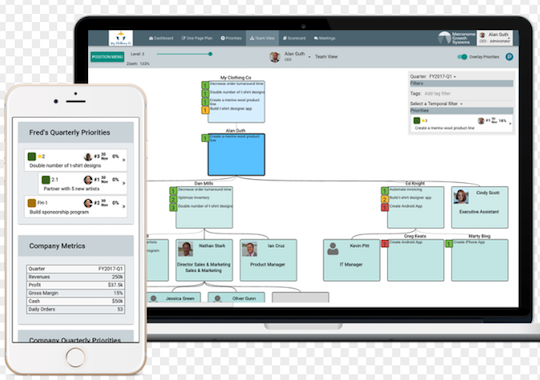You’re an ambitious CEO with your sights set on growth. You want to scale-up and have a plan to get there. Before you undo the ropes and cast off, there’s one last Rockefeller Habit to consider. The tenth and final Habit in the execution framework designed by Verne Harnish centers on office environment. And, specifically, whether your staff are surrounded by visible reminders of your plans and performance.
Why does this matter? It’s simple really. The right surroundings will keep people on track and working towards the same goal. Your success depends on this. As I mentioned in last week’s blog, every member of your team needs to understand the game they’re playing, the rules and the score in real-time. You can use your office environment to help with this clarity.
Create a ‘war-room’
Churchill knew a thing or two about successful leadership. His Cabinet War Rooms below Westminster were key to the planning of Allied Forces after 1940. The Map Room was particularly significant, manned by officers from each of the armed forces who would produce a daily intelligence summary. It’s a truly fascinating place to visit – well worth dropping by if you haven’t already.
I love taking this idea into a business. When I start working with clients, we create strategic pictures of their core values, key process flow map, activity fit map, core customer etc. Each time they return to me for off-site, planning sessions, we put these up on the walls so that we’re surrounded by visual references of what we’re trying to achieve.
I also suggest they set up their own ‘war room’ back at their offices. It’s essential to display their quarterly theme, the number they’re trying to shift and daily reporting on that number. Executives should also have their own individual, quarterly objectives on display so that, every time they meet, they can bring them into discussions. It’s about committing to fewer things but doing them well.
You also want to bring these visual reminders of quarterly progress into your monthly ‘All Hands’ meetings. Staff need to see the personal objectives of the execs and their progress towards achieving quarterly themes. How many times have I visited businesses to hear staff say there’s no communication and roll their eyes over initiatives that are started and never finished? This is your chance to show you can follow-through. Display your corporate objectives, who’s accountable for each of them and how they are progressing.
Values and Purpose are everywhere

Never miss an opportunity to display your Core Values and Purpose. Everyone in your organisation needs to live and breathe them so constant reminders are important. Don’t just include them on your website and marketing literature. Put them up on the wall. Add them to all your documentation, your security passes, anything that will reinforce the message. When you see someone displaying a behaviour linked with your values, single them out.
At Rackspace, we created separate logos for each value and put them up on a wall at the centre of our open-plan office. We always gave praise through a values lens. If we caught someone doing the right thing, we’d say thanks then write their name on a post-it note and stick it on the wall, right next to the value they’d embodied. Kudos and social currency were doled out according to Rackspace values. In monthly, all-hands meetings, team leaders would stand up and give bottles of champagne to people outside their team who’d enabled them to deliver outstanding service. Our employee of the month and quarter were all chosen by the staff based on our values.
Rackspace’s purpose was ‘Fanatical Support’ and to promote this in the business, we created the ‘Fanatical Jacket’ award. Yes – a genuine strait-jacket was presented every month to a ‘Racker’ who had shown extraordinary customer service. They got to have their photo taken wearing it and this was added to the company’s ‘Wall of Fame’. The jacket itself was displayed in a special, perspex case in Reception – a great talking point for visitors and a brilliant daily reminder for every member of staff.
Staff know the score
When I start working with clients they have no shortage of data. I ask them, ‘What are you measuring?’ ‘57 things’, they reply proudly. ‘57?!’ Eyebrows raised. ‘When do you find the time to look at them all?’ Short answer, ‘We don’t’. Totally pointless!
You need to get clear on the things that make your boat go faster. When I’m working on their Key Process Flow Map, I ask clients, what is their profit per x? What are the leading and lagging indicators that make them money? Far better to focus on these rather than 50 other things. What’s the most important priority? Work this out, communicate it clearly and then identify the critical number for the quarter that you need to shift to hit this objective.
Then it’s all about tracking and keeping score. At Macquarie Telecom, the only number they track is NPS® (Net Promoter Score). They’ve got screens up all over their buildings showing the individual NPS for each of the teams in that section. It’s all-pervasive. They talk about NPS at every meeting, whether it’s daily, weekly or monthly. Because of this obsession, they’ve driven up their score to world-class levels that are consistently in the 80s. Impressive! Hand-in-hand is a big reduction in customer churn compared with their competitors.
At Rackspace, every exec had a daily report on changes to monthly recurring revenue – just a single page of KPIs. We also got really clear on individual OKRs (Objectives and Key Results). If you worked for us, you always knew when you’d had a good day. For every role, there were numbers that could be tracked to show progress towards OKRs. And, as a result, people knew what they had to do to get better at their jobs. This made coaching conversations and staff development so much easier. It was also incredibly motivating.
There’s a common misconception that keeping score is complicated and expensive. Clients look doubtful when I suggest it. Doesn’t it involve in-depth reporting and expensive, digital technology? No! Sometimes, it’s as simple as putting up a few whiteboards. Tell your teams what you’re tracking and get them to put a mark on the board every time they do their thing, (whatever their particular thing is). Just start! You might automate it eventually but it’s amazing how effective a simple whiteboard can be.
We had a “Q-Team” at Peer 1 who generated leads for the sales team. Every time they booked an appointment, they marked the board. At the end of each day, week and month, we totted up the scores. Rewards were dolled out for the highest-scoring team member and celebrations were planned when teams hit their target. Then it was back to square one – we rubbed the board clean and started again.
One thing’s for sure. If you give people the score in real-time, it will change their behaviour. As well as motivation, you can tap into their sense of competition. Great example – I once heard about a steel company who wanted to drive up production. One day, the manager of the day shift got a stub of chalk and wrote ‘11’ on the floor. This was the number of tonnes they’d rolled that day. When the Night Shift Manager arrived, he asked what that ‘11’ was all about. And then at the end of his shift, he chalked a giant ‘13’ in its place. And so it continued.
Systems track KPIs and Priorities

The final point of Rockefeller Habit #10 focuses on getting a measurement system in place to keep your company on track. To my mind, the best out there is MGS® (Metronome Growth Software) and I offer this to all my clients. It’s a cloud-based business platform that centres around a one-page strategic plan and allows all members of staff to input their top priorities and metrics. I love the way it promotes an environment of ownership and accountability, with every team member able to see where they need to focus to achieve company goals.
MGS is really useful for cascading priorities. It allows you to create a virtual war room and shows the co-dependencies between objectives. You can see your boss’s targets and then how your own objectives link to these. And you can see your individual progress in real-time.
I suggest Chief Executives start by rolling it out to the leadership team first before taking it wider to the rest of the company. I help them create their one-page strategic plan and upload this with all the other strategic pictures we’ve produced in our off-site sessions. Columns 6 and 7 of the one-page plan include corporate objectives for the next 90 days as well as individual priorities. So, when the team meets for its daily huddles and weekly meetings, they can reference their progress using MGS.
There we have it. My blog series on the Rockefeller Habits is now complete. I hope you’ve found them useful – if you need any help introducing these habits to your company, do get in touch.
Written by business growth coach Dom Monkhouse. Find out more about his work here.

